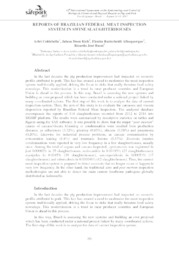Reports of Brazilian federal meat inspection system in swine slaughterhouses.
Reports of Brazilian federal meat inspection system in swine slaughterhouses.
Author(s): COLDEBELLA, A.; KICH, J. D.; ALBUQUERQUE, E. R.; BUOSI, R. J.
Summary: Abstract In the last decades the pig production improvement had impacted on zoonotic profile attributed to pork. This fact has created a need to modernize the meat inspection system traditionally applied, driving the focus to risks that really threaten food safety nowadays. This modernization is a trend in meat producer countries and European Union is ahead in this process. In this way, Brazil is assessing the new systems and building an own proposal which has been conducted under a national project linked by many coordinated actions. The first step of this work is to analyze the data of current inspection system. Then, the aim of this study is to evaluate the carcasses and viscera disposition reported by Brazilian Federal Meat Inspection. The analyzed database encompasses the reports of 114 slaughterhouses recorded from 2012 to 2014 into SIGSIF platform. The results were summarized by descriptive statistics on tables and figures using the SAS software. It was possible to show that the major ?post mortem? causes of carcass/viscera trimming or condemnation were resulted from production diseases, as adherences (3.72%), pleurisy (0.85%), abscess (0.58%) and pneumonia (0.20%). Likewise for industrial process problems, as carcass contamination by evisceration leaking (1.8%) and traumatic lesions (1.57%). Zoonosis injuries condemnations were reported in very low frequency in a few slaughterhouses, usually once. Among the total of organs and carcass inspected, cysticercosis was registered in just 0.00092% in 25 slaughterhouses, endocarditis in 0.00193% (23 slaughterhouses), erysipelas in 0.0045% (38 slaughterhouses), sarcosporidiosis in 0.00051% (17 slaughterhouses) and tuberculosis in 0.000046% (12 slaughterhouses). Thus, the current meat inspection system is prepared to detect zoonosis that no longer occur or happen in very low frequency. In the other hand, the traditional ante and post mortem inspection methodologies are not able to detect the main current foodborne pathogens globally distributed as Salmonella.
Publication year: 2017
Types of publication: Paper in annals and proceedings
Unit: Embrapa Swine & Poultry
Observation
Some of Embrapa's publications are published as ePub files. To read them, use or download one of the following free software options to your computer or mobile device. Android: Google Play Books; IOS: iBooks; Windows and Linux: Calibre.
Access other publications
Access the Agricultural Research Database (BDPA) to consult Embrapa's full library collection and records.
Visit Embrapa Bookstore to purchase books and other publications sold by Embrapa.

